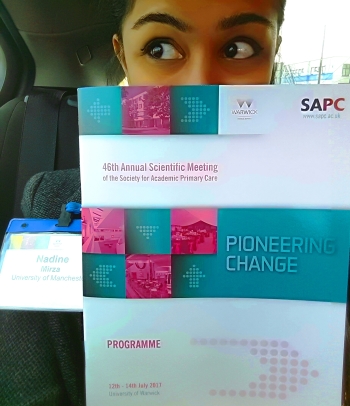First published on the blogsite: The Almost Psychologist by Nadine Mizra.
The Almost Psychologist by Nadine Mizra, PhD student (Mental Health) at the Centre for Primary Care, Institute of Population Health, University of Manchester.
Two months ago I posted about my experience at SAPC ASM 2017, mentioning only a tidbit about my attendance. Divine intervention likes to see me squirm so my poster abstract was accepted on an oral basis and despite being honoured I was confused by the type of presentation I had to give- an elevator pitch.
We’re used to traditional presentation formats of 10-15 minutes, using a dozen slides to narrate the background, methodology and findings of our research, sticking to a semi formal script that tells the full story of our work. But that’s not what an elevator pitch is.
The idea lies in the name- imagine yourself on an elevator ride, trying to convince someone to fund your work, before it ends. It’s roughly a few minutes, limited to 3-4 slides, built around brevity, and serving a different purpose than that of a typical presentation. Akin to a sales pitch, the concept is to sell your research. Therefore, the aim is to select the highlights of your work and frame it to grip both scientific and lay audiences. If a presentation is a 90 minute movie an elevator pitch would be the trailer, designed to fill the theatres.
You’d think this would mean less stress but in fact, more effort was required to adjust to this dynamic. How could I hook an audience and have them realise the importance of my work in just three minutes?

Do your research: Most conferences will provide information on EPs and their expectations of what you should detail. I spent a good while perusing the SAPC website for this information, reading up on the format, and watching a lot of previous pitches on YouTube.
Know the rules: Conferences are strict about time and this goes twice for EPs. The same applies to the number of slides allowed, and this may include the title slide; I knew I had 3 minutes with 3 slides.
Starting off: Start with an attention grabber- a startling fact, question or quote. One pitch started with a funny quote the researcher had chosen from her transcripts, making me want to know more about her work. This technique makes the audience feel actively spoken with, not passively spoken to. I opened with a question to direct the audience’s attention to an existing problem and have them ponder it: “What would you say if I told you that when it comes to designing dementia research we are neglecting 14% of the population?”
Pitch content: The objectives and summary should be scrapped and you don’t have to discuss all your research – if you had multiple findings choose to focus on one. Instead of a substantial background speak about 2-3 points related to the “problem” and your subsequent solution, taking up one slide to convince the audience that the problem is prominent and your solution is necessary. The methods section would be half a slide of steps you would spend only a few seconds listing. Your findings would be expressed in half or one slide, highlighting an example from your results, reiterating how this relates to the problem you initially stated. If you have time, say a word about the implications of your research, showing how investing in it would reap rewards.
Closing off: End the pitch with another attention grabber that forces the audience to respond. For my pitch, which focused on identifying the issues researchers face when designing dementia research for ethnic minorities, I drove the point home with an example in my results; there is no South Asian equivalent for the word dementia. It was my most hard hitting example and could lead to me concluding by asking the audience “How can we hope to conduct valid, reliable and ethical dementia research in a group that doesn’t have the word for dementia? We can’t. And that’s why this research is important”.



Designing your slides: You have limited real estate so avoid cluttered slides. A few concise and well-labelled points will be easier to read and remember than a tedious paragraph. I avoided overused fonts like Times New Roman and Calibri, keeping the size large, and text scarce with tables and figures. I stuck to white slides with a simple but appealing colour scheme and made an effort to compress information into figures since they pop out and promote retention.
Contacts: Make sure your slides provide contact information. On the last slide I had my email address and other attendees did better, including their Facebook profiles and Twitter handles. Extending to ResearchGate and LinkedIn is never amiss and you can also offer to give out your personal card.
Practice makes perfect: Practicing with a timer teaches you how to speak at a gradual pace while still conveying everything, with essential pauses for the audience to digest. The audience needs to be able to follow you. I even video recorded myself so I could listen back to decide if any words were redundant and taking up precious seconds. To save more time, create and remember a script of your pitch, which will allow you to present without looking at the slides. Practice open armed, enthusiastic body language to make the pitch seem casual and therefore, you, more approachable.
On the day: I was nervous and spent intervals reciting my pitch, mobile stopwatch on, while stuffing my face with the chocolate muffins being served. In between this personal crisis I asked for advice from those who had pitched before, double checked with the mediator to confirm the rules and promoted my pitch on Twitter. Afterwards, I stayed back in the room to answer questions – there’s no point in selling an idea if you’re not around after to discuss the fine print.
The elevator pitch was definitely an endeavor I’d repeat now that the daunting initial try is over. In fact, I find the format far more creative and engaging than your mainstream presentations, firing off my pitch from behind a podium- but maybe that’s because I only had to speak for 3 minutes.

Contact Nadine: nadine.k.mirza@gmail.com
